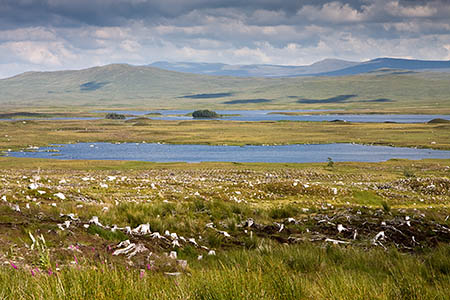Mountaineers are objecting to plans for a 24-turbine windfarm in the shadow of Highland peaks Ben Alder and Schiehallion.
The proposed development is seen by the Mountaineering Council of Scotland as a test of the resolve of the Scottish Government to protect wild land.
The planned Talladh-a-Bheithe windfarm would be in an area identified as having nationally significant under planning policy. The policy calls for significant protection from development, the MCofS said.
The windfarm, with turbines up to 125m (410ft) high, would even be visible from the main road over Rannoch Moor, leading to Glencoe and the western Highlands.
Talladh-a-Bheithe Wind Farm has applied for permission to the turbines and associated bulldozed access tracks, buildings and infrastructure, on an area of raised moorland between Loch Rannoch and Loch Ericht.
The MCofS said, if given the go-ahead, the windfarm would also be visible from the mountains above Glen Lyon and Loch Tay and some above the Drumochter Pass.
MCofS chief officer David Gibson said: “We support the Scottish Government’s drive to develop renewable energy in all its forms and have welcomed the new planning policy which aims to balance the need for renewable energy with significant protection for wild land.
“This proposal presents ministers with the opportunity to prove they are serious about protecting our most precious wild landscapes.
“Schiehallion, Rannoch Moor and the route to Glencoe all have a very special place in people’s hearts and in Scottish culture, and this proposal would affect an area which has a unique landscape character offering panoramic views over a fantastic area of wild land.
“It is a stunning landscape vista which is very sensitive to any form of intrusive human activity and an increasingly rare and valuable experience in Scotland.
“Any presumed benefit from this development would be far outweighed by the damage it would do to such a distinctive landscape which is vital not only to highland Perthshire’s identity but also to Scotland’s international image.
“There might be a reason for the approval of this proposal if there was a dearth of onshore wind farm developments coming forward to achieve the Scottish Government’s energy goals, but this is not the case, so Talladh-a-Bheithe cannot be considered a necessary development, far less an essential one, and it’s certainly not in the national interest.”
The windfarm company said: “It has been assessed that there would be significant effects on landscape character and visual amenity within parts of the Loch Rannoch and Glen Lyon national scenic area. It is not considered however that the proposals would have significant harm to the special qualities of the NSA.
“The mountain grandeur, wild summits and natural beauty within the NSA would not be directly affected by the proposed development, which lies beyond the NSA boundary with the nearest turbine over 1.8km away, and would remain appreciable following construction of the development.
“There would be no significant effect on any of the other national parks or national scenic areas which are located within the study area. These include the Cairngorms national park and the Ben Nevis and Glen Coe NSA.
“With regard to the Ben Alder area of search for wild land, it is judged that while being located within a search area the northern part of the Talladh-a-Bheithe estate does not have the same characteristics and attributes of core wild land as much of the central section of the search area to the West of Ben Alder and to the East of Ben Nevis.
“These areas are more rugged, remote and inaccessible when compared to the Talladh-a-Bheithe estate which lies adjacent to a loch managed and dammed as part of hydroelectric generation scheme and areas of plantation forestry and is traversed by a Tarmac road.
“However, should it be considered that this area did form wild land, it is acknowledged that the assessment of effects on visual amenity landscape character did identify some significant effects within this area.”
The MCofS objection to the plan notes that there are 54 munros and corbetts within 35km of the site, from which the development would be visible.


Tom Forrest
10 July 2014If given the go ahead it will also open the door to Loch Ericht north end at Dalwhinnie, they are planning some major works there to enable transport of sections along the loch by barge. This will then have in place the infrastructure to encourage continuation further down Loch Ericht side to join with Talla Bheith.The landscape will if granted already be scarred so a few more in the eye of the developer and Alec's cronies won't make any difference. Ben Alder Cottage, tranquility with the gentle hum of the turbine forest across the water, no thanks. This seems to be a continuing pattern as with Coirremoille the Scot Gov granted 17 closely followed by applications for two more adjacent projects which were subsequently granted, of note is the fact that the local communities by an overwhelming majority objected, Alec and co discounted their nimby rants and allowed the abominations to be constructed. Makeup of the new Scotland?, 30% wild land, 69% turbines and 1% Central Belt and Holywood, sorry Sean/Alec meant Holyrood.
Jack and Anne Greenway.
14 July 2014This proposed development is more environmental vandalism. It is inexcusable and totally unnecessary, inflicting criminal damage on our country for minimal benefit. It is only happening because there are subsidies, which will cease to exist if there is a vote for independence. Scotland will then be left with a variable surplus of expensive energy which no one is going to buy. When, if ever, will we have a sane, balanced energy policy?